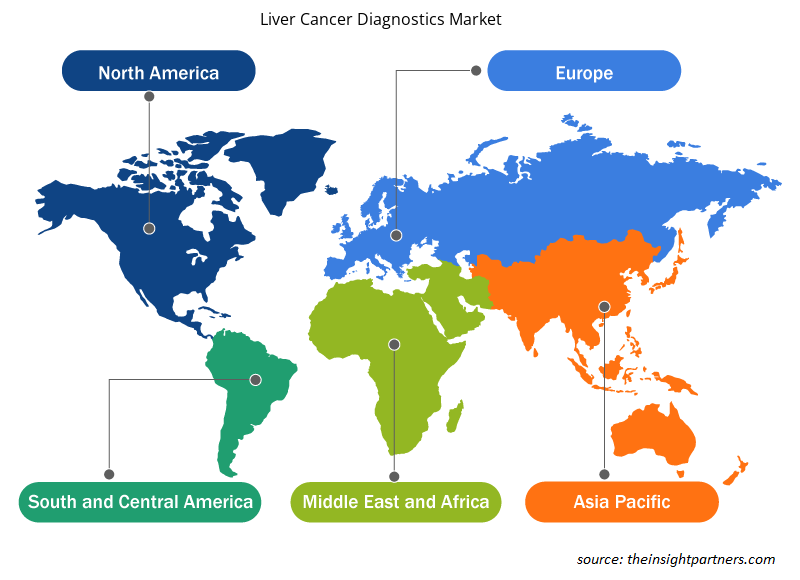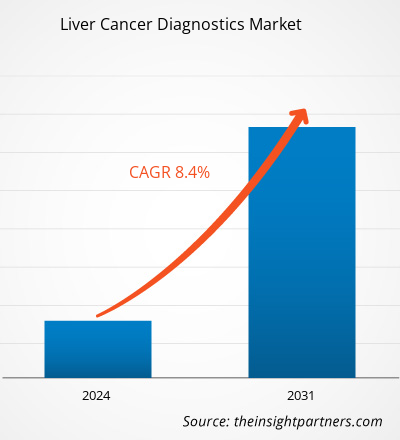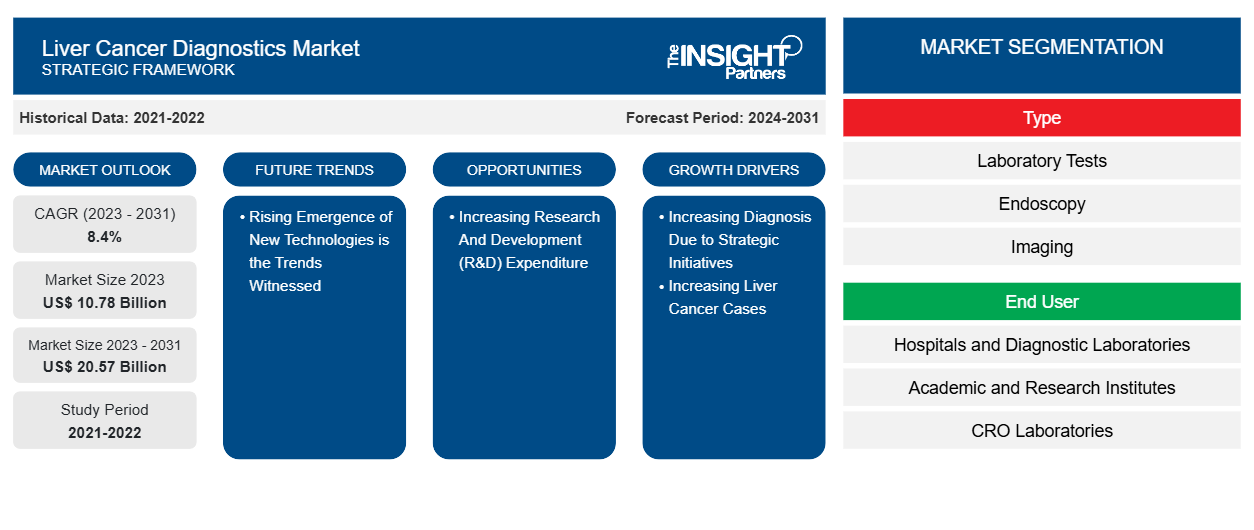Si prevede che la dimensione del mercato della diagnostica del cancro al fegato raggiungerà i 20,57 miliardi di dollari entro il 2031, rispetto ai 10,78 miliardi di dollari del 2023. Si prevede che il mercato registrerà un CAGR dell'8,4% nel periodo 2023-2031. È probabile che la crescente comparsa di nuove tecnologie rimanga una tendenza chiave nel mercato.
Analisi di mercato della diagnostica del cancro al fegato
Secondo il CDC, ogni anno negli Stati Uniti, circa 24.500 uomini e 10.000 donne sviluppano un cancro al fegato, di cui 18.600 uomini e 9.000 donne muoiono a causa della malattia. I casi di cancro al fegato negli americani sono in aumento da diversi decenni. Il carcinoma epatocellulare (HCC) è il cancro al fegato più comune negli Stati Uniti. Inoltre, secondo il governo canadese, circa 1 adulto canadese su 4 (26,6%) vive attualmente con l'obesità. Anche i casi di obesità sono in aumento e con l'aumento dei casi aumenta anche il rischio di determinate condizioni di salute come danni al fegato, diabete, ipertensione e malattie cardiache.
Panoramica del mercato della diagnostica del cancro al fegato
Nel 2020, l'Organizzazione Mondiale della Sanità (OMS) ha dichiarato che nel mondo si sono verificati oltre 10 milioni di decessi, di cui uno su sei dovuto al cancro. Inoltre, nel 2020, il cancro al fegato è uno dei tipi di cancro più comuni, rappresentando circa il 4,7% di tutti i nuovi casi di cancro e l'8,3% di tutti i decessi per cancro. Di tutti i casi di cancro al fegato diagnosticati, dal 75% al 90% sono carcinoma epatocellulare (HCC), che ha un impatto più significativo sui decessi correlati al cancro. Secondo l'articolo pubblicato su CCO (Chinese Clinical Oncology), il cancro epatocellulare (HCC) è una delle principali cause di morte per cancro in tutto il mondo. Le procedure più utilizzate per lo screening dell'HCC sono il test dell'alfa-fetoproteina sierica (AFP) e l'ecografia epatica. Tuttavia, in termini di sensibilità, il test AFP ha una sensibilità dal 25% al 65% e l'ecografia ha una sensibilità superiore al 60%. Il cancro al fegato è un cancro più comune e i casi sono in aumento. Ad esempio, nel Regno Unito si prevede che i tassi di mortalità per HCC aumenteranno del 14% entro il 2025, rappresentando il più grande incremento tra tutti i tipi di cancro.
Personalizza questo report in base alle tue esigenze
Riceverai la personalizzazione gratuita di qualsiasi report, comprese parti di questo report, o analisi a livello nazionale, pacchetto dati Excel, oltre a usufruire di grandi offerte e sconti per start-up e università
-
Scopri le principali tendenze di mercato in questo rapporto.Questo campione GRATUITO includerà analisi di dati che spaziano dalle tendenze di mercato alle stime e alle previsioni.
Driver e opportunità del mercato della diagnostica del cancro al fegato
Aumento delle diagnosi grazie alle iniziative strategiche per favorire il mercato
A giugno 2020, gli scienziati dell'NCI hanno sviluppato un nuovo test per lo screening del carcinoma epatocellulare (HCC), la forma più comune di cancro al fegato. Questo screening prevede un esame del sangue per indagare la precedente esposizione del paziente a determinati virus. Tale screening porta a una diagnosi e a una diagnosi precoci, principalmente perché vengono rilevati tumori in fase avanzata o avanzata, che a quel punto sono spesso incurabili. Inoltre, l'NCI ha anche lanciato il programma CCR Liver Cancer per sviluppare nuovi metodi per la diagnosi, la diagnosi e il trattamento precoci, con l'obiettivo di migliorare i risultati dei pazienti con HCC. Inoltre, il National Institutes of Health (NIH) ha avviato la sua rete di sperimentazioni cliniche per valutare possibili aiuti e problemi di nuove promettenti tecnologie di screening del cancro e per governare i metodi efficienti per integrare queste innovazioni nei protocolli di cura standard.
Aumento della spesa per la ricerca e lo sviluppo (R&S)
Nel 2021, la spesa per ricerca e sviluppo (R&S) di Elecsys GALAD è stata di 14,65 miliardi di dollari USA e nel 2020 è stata di 13,17 miliardi di dollari USA. È aumentata del 14% su base core. Inoltre, la R&S di F. Hoffmann-La Roche Ltd è aumentata principalmente per investimenti in fase avanzata in oncologia, oftalmologia e assistenza sanitaria personalizzata. Inoltre, a giugno 2020, gli scienziati del National Institutes of Health (NIH) hanno lanciato esami del sangue per migliorare lo screening del cancro al fegato, gestiti dai ricercatori del National Cancer Institute (NCI). Pertanto, i crescenti investimenti in R&S e lo sviluppo di test diagnostici per il cancro al fegato stanno guidando il mercato della diagnostica del cancro al fegato.
Analisi della segmentazione del rapporto di mercato sulla diagnostica del cancro al fegato
I segmenti chiave che hanno contribuito alla derivazione dell'analisi di mercato della diagnostica del cancro al fegato sono la tipologia e l'utente finale.
- In base al tipo, il mercato è suddiviso in test di laboratorio, endoscopia , imaging, biopsia e altri. Il segmento dei test di laboratorio ha detenuto una quota di mercato maggiore nel 2023.
- In base all'utente finale, il mercato è suddiviso in ospedali e laboratori diagnostici, istituti accademici e di ricerca e laboratori CRO. Il segmento ospedali e laboratori diagnostici ha detenuto una quota di mercato maggiore nel 2023.
Analisi della quota di mercato della diagnostica del cancro al fegato per area geografica
L'ambito geografico del rapporto di mercato sulla diagnostica del cancro al fegato è suddiviso principalmente in cinque regioni: Nord America, Asia Pacifico, Europa, Medio Oriente e Africa, e Sud e Centro America.
Il Nord America ha dominato il mercato e si prevede che l'Asia Pacifica crescerà con il CAGR più elevato nei prossimi anni. La crescita del mercato dell'Asia Pacifica è dovuta all'aumento della popolazione anziana e all'espansione delle opzioni di trattamento del cancro al fegato. Grazie all'implementazione di procedure diagnostiche migliorate per il cancro al fegato in paesi come India e Cina, si prevede che la regione APAC avrà il CAGR più elevato. Con il miglioramento dell'economicità delle soluzioni diagnostiche, si prevede che la domanda di diagnosi del cancro al fegato nei laboratori diagnostici indipendenti nell'APAC aumenterà. I fattori di cui sopra spingeranno il mercato della diagnosi del cancro al fegato.
Approfondimenti regionali sul mercato della diagnostica del cancro al fegato
Le tendenze regionali e i fattori che influenzano il mercato della diagnostica del cancro al fegato durante il periodo di previsione sono stati ampiamente spiegati dagli analisti di Insight Partners. Questa sezione discute anche i segmenti e la geografia del mercato della diagnostica del cancro al fegato in Nord America, Europa, Asia Pacifico, Medio Oriente e Africa e America meridionale e centrale.

- Ottieni i dati specifici regionali per il mercato della diagnostica del cancro al fegato
Ambito del rapporto di mercato sulla diagnostica del cancro al fegato
| Attributo del report | Dettagli |
|---|---|
| Dimensioni del mercato nel 2023 | 10,78 miliardi di dollari USA |
| Dimensioni del mercato entro il 2031 | 20,57 miliardi di dollari USA |
| CAGR globale (2023-2031) | 8,4% |
| Dati storici | 2021-2022 |
| Periodo di previsione | 2024-2031 |
| Segmenti coperti |
Per tipo
|
| Regioni e Paesi coperti |
America del Nord
|
| Leader di mercato e profili aziendali chiave |
|
Densità degli attori del mercato della diagnostica del cancro al fegato: comprendere il suo impatto sulle dinamiche aziendali
Il mercato della diagnostica del cancro al fegato sta crescendo rapidamente, spinto dalla crescente domanda degli utenti finali dovuta a fattori quali l'evoluzione delle preferenze dei consumatori, i progressi tecnologici e una maggiore consapevolezza dei benefici del prodotto. Con l'aumento della domanda, le aziende stanno ampliando le loro offerte, innovando per soddisfare le esigenze dei consumatori e capitalizzando sulle tendenze emergenti, il che alimenta ulteriormente la crescita del mercato.
La densità degli operatori di mercato si riferisce alla distribuzione di aziende o società che operano in un particolare mercato o settore. Indica quanti concorrenti (operatori di mercato) sono presenti in un dato spazio di mercato in relazione alle sue dimensioni o al valore di mercato totale.
Le principali aziende che operano nel mercato della diagnostica del cancro al fegato sono:
- Abate,
- BioMérieux SA,
- F. HOFFMANN-LA ROCHE LTD,
- Illumina, Inc.,
- Koninklijke Philips NV,
- QIAGEN,
Disclaimer : le aziende elencate sopra non sono classificate secondo un ordine particolare.

- Ottieni una panoramica dei principali attori del mercato della diagnostica del cancro al fegato
Notizie di mercato e sviluppi recenti sulla diagnostica del cancro al fegato
Il mercato della diagnostica del cancro al fegato viene valutato raccogliendo dati qualitativi e quantitativi post-ricerca primaria e secondaria, che includono importanti pubblicazioni aziendali, dati di associazioni e database. Di seguito sono elencati alcuni degli sviluppi nel mercato della diagnostica del cancro al fegato:
- Illumina, Inc. ha lanciato il test oncologico TruSight per la valutazione di più geni tumorali e biomarcatori. Il test TruSight inizierà presto il suo lancio globale in Europa. Valuta i geni tumorali e i biomarcatori per scoprire il profilo molecolare specifico del cancro di un paziente, aiutando a informare le decisioni di medicina di precisione. (Fonte: Illumina, Inc., comunicato stampa, marzo 2022)
- Perspectum ha stretto una partnership con HepQuant per fornire la tecnologia di valutazione della funzionalità epatica di HepQuant tramite i servizi di Contract Research Organization (CRO) di Perspectum. Questa collaborazione ha consentito alle aziende farmaceutiche che supportano sperimentazioni cliniche per malattie epatiche, tra cui cirrosi epatica, steatoepatite non alcolica (NASH), malattie epatiche autoimmuni e cancro al fegato di ricevere conoscenze su imaging e test di funzionalità da Pharma Solutions di Perspectum. (Fonte: Perspectum, comunicato stampa, novembre 2021)
Copertura e risultati del rapporto di mercato sulla diagnostica del cancro al fegato
Il rapporto "Dimensioni e previsioni del mercato della diagnostica del cancro al fegato (2021-2031)" fornisce un'analisi dettagliata del mercato che copre le seguenti aree:
- Dimensioni e previsioni del mercato della diagnostica del cancro al fegato a livello globale, regionale e nazionale per tutti i principali segmenti di mercato coperti dall'ambito
- Tendenze del mercato della diagnostica del cancro al fegato, nonché dinamiche di mercato quali fattori trainanti, limitazioni e opportunità chiave
- Analisi dettagliata delle cinque forze PEST/Porter e SWOT
- Analisi di mercato della diagnostica del cancro al fegato che copre le principali tendenze del mercato, il quadro globale e regionale, i principali attori, le normative e i recenti sviluppi del mercato3
- Analisi del panorama industriale e della concorrenza che copre la concentrazione del mercato, l'analisi della mappa di calore, i principali attori e gli sviluppi recenti nel mercato della diagnostica del cancro al fegato
- Profili aziendali dettagliati
- Analisi storica (2 anni), anno base, previsione (7 anni) con CAGR
- Analisi PEST e SWOT
- Valore/volume delle dimensioni del mercato - Globale, Regionale, Nazionale
- Industria e panorama competitivo
- Set di dati Excel
Report recenti
Rapporti correlati
Testimonianze
Motivo dell'acquisto
- Processo decisionale informato
- Comprensione delle dinamiche di mercato
- Analisi competitiva
- Analisi dei clienti
- Previsioni di mercato
- Mitigazione del rischio
- Pianificazione strategica
- Giustificazione degli investimenti
- Identificazione dei mercati emergenti
- Miglioramento delle strategie di marketing
- Aumento dell'efficienza operativa
- Allineamento alle tendenze normative























 Ottieni un campione gratuito per - Mercato della diagnostica del cancro al fegato
Ottieni un campione gratuito per - Mercato della diagnostica del cancro al fegato